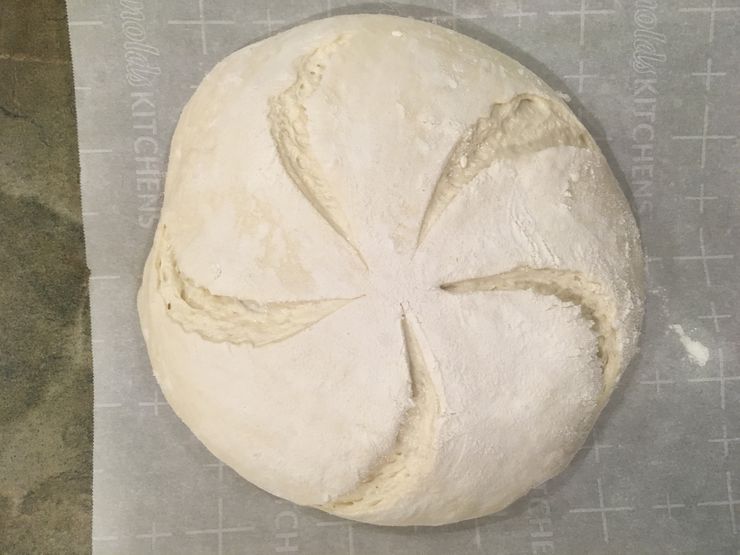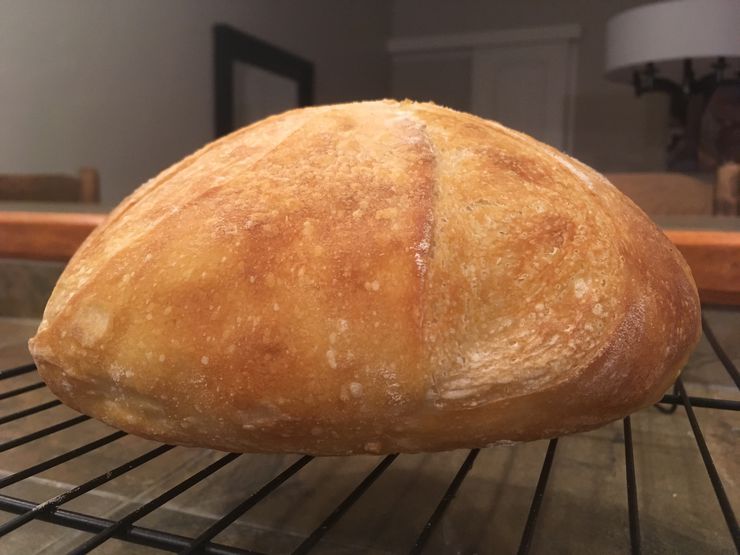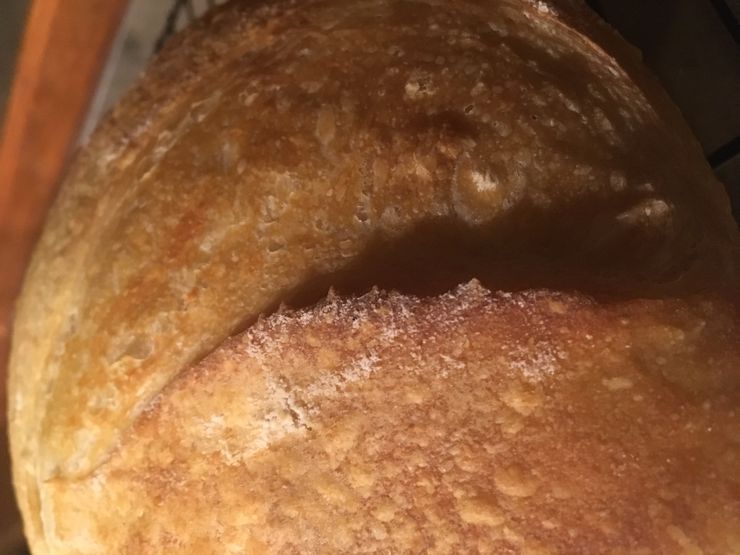2018-10-05
Based on
Influences
https://brodandtaylor.com/make-sourdough-more-sour/
https://www.culturesforhealth.com/learn/sourdough/how-to-make-truly-sour-sourdough-bread/
http://www.thefreshloaf.com/node/1040/lesson-squeeze-more-sour-your-sourdough
https://www.culturesforhealth.com/learn/sourdough/how-altitude-affects-sourdough-baking/
Ingredients
| Ingredient | Weight (grams) | Baker’s Percentage |
|---|---|---|
| King Arthur Bread Flour | 444.0 | 100.0% |
| Filtered water | 275.0 | 61.9% |
| Kosher salt | 9.1 | 2.0% |
| Sourdough Starter * | 300.0 | 67.6% |
* Ischia Island (Italy) sourdough starter at 100% hydration
Process
Feed starter and allow to ferment at 77.4 degrees Fahrenheit for 6 hours. I use a sous vide circulator to maintain temperature while fermenting starter.
Mix 400 grams of flour and all of the water until combined, cover, and rest (autolyse) for 40 minutes.
Add salt and sourdough starter. Mix using Kitchen Aid mixer with dough hook on the lowest speed for 12 minutes. Add more flour (I added 44 grams) to form a stable, but rather wet dough.
Transfer to a lightly olive-oiled container with top, cover, and bulk ferment for 3 hours at approximately 70 degrees Fahrenheit.
Transfer to refrigerator (37 degrees Fahrenheit) and ferment for an additional 19 hours.
Remove dough from refrigerator and allow it to warm up at room temperature for 1 hour.
Flour work surface. Fold dough into thirds 5 times. Add flour if needed to form a firm dough.
Preheat oven to 410 degrees Fahrenheit with a cast iron skillet on the bottom rack.
Shape dough into a round, and place seam-side-up in banneton. Wrap banneton in plastic wrap and allow to proof at 68 degrees Fahrenheit until dough passes the poke test (about another hour and 20 minutes).
Turn dough out of banneton, onto parchment paper. Flour the top of the loaf and score with a razor blade at a 30 degree angle.
Place loaf and parchment paper in hot cast iron skillet, spray with filtered water, place top on skillet, and spray sides of oven with water. Close oven door immediately.
Bake with top on the cast iron skillet for the first 20 minutes, then remove top and spray top of loaf and sides of oven again with filtered water. Close oven door immediately.
When internal temperature reaches 192 degrees Fahrenheit, turn oven temperature to 450 degrees Fahrenheit and turn on convection bake cycle. Bake until internal temperature reaches 194 degrees, approximately 25 minutes after removing the top from the cast iron skillet. (NOTE: this temperature is much lower than normal since I’m baking at an elevation of ~8700 feet)
Notes
Dough was a good consistency after bulk fermentation, and required only a little more than standard bench flour to work.
Dough wasn’t particularly stretchy after bulk fermentation, and required resting for a few minutes to perform the last two stretch/folds.
Bottom of loaf sounded nice and hollow immediately after removing from oven.
Oven spring was good, but could be better.
Salt content was great.
Crumb and crust were great. Crumb was slightly moist and crust was perfectly crispy but could have been a little darker.
Very little sour flavor.
Images






Upcoming experiments
Consider bulk fermenting the dough for several days in the refrigerator to try to develop a much more sour flavor.
Consider making the dough a bit drier for the bulk fermentation stage. Some articles mention that a drier starter makes a more sour bread. Might extend to the bulk fermentation phase as well. This bread was (275+150)/(444+150)=71.5+% hydration during bulk ferment; maybe try to get below 68% (or lower) and see how it goes.
Consider using a banneton without liner for improved shape.
Consider turning on convection bake (and turning oven temp to 450 degrees Fahrenheit) earlier, maybe when internal temperature is 185 or 190 degrees Fahrenheit. Also consider leaving loaf in the oven for ~5 minutes after it reaches 194 degrees Fahrenheit.
Consider scoring in two parallel lines down the middle, with “ears” pointing inward (angle blade 30 degrees inward on each score). Also consider scoring more deeply.